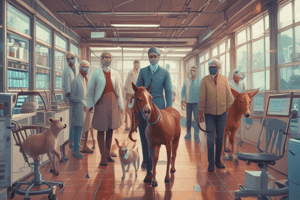Podcast
Questions and Answers
When does the disease process begin?
When does the disease process begin?
When the disease causing pathogen/germ enters the body at the correct entry site
What are the most common pathogens?
What are the most common pathogens?
- Bacteria and viruses (correct)
- Fungi and parasites
- Prions and protozoa
What are commonly prescribed to fight bacterial infections?
What are commonly prescribed to fight bacterial infections?
Antibiotics
Which of the following are pathogens of most concern?
Which of the following are pathogens of most concern?
What is necessary for a blood-borne pathogen to be transmitted?
What is necessary for a blood-borne pathogen to be transmitted?
Blood splashing in the eyes is an example of what type of contact?
Blood splashing in the eyes is an example of what type of contact?
What is indirect contact?
What is indirect contact?
What is vector-borne transmission?
What is vector-borne transmission?
What is droplet transmission?
What is droplet transmission?
What vaccine does OSHA require to be made available to all employees who have potential exposure to blood-borne pathogens?
What vaccine does OSHA require to be made available to all employees who have potential exposure to blood-borne pathogens?
What does AVPU stand for?
What does AVPU stand for?
If you suspect head, neck or spine injury, what should you do to open the airway?
If you suspect head, neck or spine injury, what should you do to open the airway?
Following a scene size-up, what is usually the next step in assessing the patient?
Following a scene size-up, what is usually the next step in assessing the patient?
If it is determined that the victim has no pulse and is not breathing, the next step should be?
If it is determined that the victim has no pulse and is not breathing, the next step should be?
Flashcards
When does the disease process begin?
When does the disease process begin?
When the disease-causing pathogen enters the body at the correct entry site.
What are the most common pathogens?
What are the most common pathogens?
Bacteria and viruses are the most common disease-causing organisms.
What are commonly prescribed to fight bacteria infections?
What are commonly prescribed to fight bacteria infections?
Antibiotics are medications used to treat bacterial infections.
What are the 3 pathogens of most concern?
What are the 3 pathogens of most concern?
Signup and view all the flashcards
What is necessary for a bloodborne pathogen to be transmitted?
What is necessary for a bloodborne pathogen to be transmitted?
Signup and view all the flashcards
Blood splashing in the eyes is an example of what type of contact?
Blood splashing in the eyes is an example of what type of contact?
Signup and view all the flashcards
Indirect contact
Indirect contact
Signup and view all the flashcards
Vector-borne
Vector-borne
Signup and view all the flashcards
Droplet
Droplet
Signup and view all the flashcards
What vaccine does OSHA require to be made available to all employees who have potential exposure?
What vaccine does OSHA require to be made available to all employees who have potential exposure?
Signup and view all the flashcards
What does AVPU stand for?
What does AVPU stand for?
Signup and view all the flashcards
If you suspect head, neck or spine injury, what should you do to open the airway?
If you suspect head, neck or spine injury, what should you do to open the airway?
Signup and view all the flashcards
Following a scene size up what is usually the next step in assessing the patient?
Following a scene size up what is usually the next step in assessing the patient?
Signup and view all the flashcards
If it is determined that the victim has no pulse and is not breathing the next step should be
If it is determined that the victim has no pulse and is not breathing the next step should be
Signup and view all the flashcards
Study Notes
Disease Transmission
- Disease process starts when a pathogen enters the body at a specific entry site.
- Common pathogens are bacteria and viruses.
- Antibiotics commonly treat bacterial infections.
- Hepatitis B, C, and HIV are pathogens of significant concern.
- Bloodborne pathogen transmission requires the pathogen, sufficient quantity, correct entry site, and a susceptible person.
Contact Types
- Direct contact: Blood splashing in the eyes is an example.
- Indirect contact: Transmission through contaminated objects.
- Vector-borne: Transmission via an intermediate host (insect or animal).
- Droplet transmission: Transmission via airborne droplets.
Workplace Safety
- OSHA requires Hepatitis B vaccination for employees with potential exposure.
Patient Assessment
- AVPU: Alert, Verbal response, Painful response, Unresponsive.
- Head, neck, or spine injury suspected: Use jaw-thrust maneuver to open the airway.
- Post scene size-up: Perform a primary assessment.
- No pulse and no breathing: Initiate CPR.
Studying That Suits You
Use AI to generate personalized quizzes and flashcards to suit your learning preferences.




